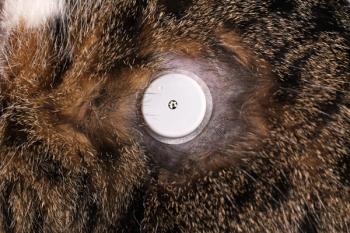
6 tips for managing canine and feline diabetes
Some knowledge to help you master this endocrine disorderand save your veterinary patients lives.
Even though diabetes is a treatable condition, pet owners are being asked to do a lot to manage their pet's disease, making communication with the veterinary team essential. (Photo: Trsakaoe/stock.adobe.com)Do you know the No. 1 cause of death in diabetic dogs and cats? It's not the disease itself. Rather, it's euthanasia resulting from the owner's frustration with the disease. This means communication with the pet owner is perhaps the most important component of managing diabetes mellitus. And the most crucial conversation you'll likely have with the owner is right after you first diagnose the condition. With that in mind, let's look at six ways you can help your clients manage their insulin-challenged pets.
1. Explain the goals of therapy for diabetic pets.
Unlike in humans, who live with diabetes for 20, 30 or 40 years, sequelae such as diabetic retinopathy, nephropathy, painful neuropathies and cardiovascular disease are rare in our veterinary patients. Our patients don't live as long, so we don't need to restore euglycemia in order to avoid the effects of persistent hyperglycemia. We just need enough glycemic control to eliminate clinical signs, which means keeping the blood glucose concentrations below the renal threshold for the majority of the day.
In most cases this is going to require twice-daily injections of insulin. And even though the disease is easier to manage in pets than people, owners of diabetic dogs and cats are still being asked to do a great deal to help manage their pet's chronic illness. That means we need to do whatever we can to make the client's job easier while at the same time taking steps to assure maximum diabetic control.
2. Go for broke on remission when you first diagnose a cat.
Of course, even better than effective management is complete remission of the disease. And thanks to the work of Jacquie Rand, BVSc, DVSc, MANZCVS, DACVIM, of Queensland, Australia, we know that this is highly likely in cats if we take an aggressive approach right out of the gate. Insulin glargine has been shown to produce remission in 90 percent of newly diagnosed feline diabetics when the cat is also fed a high-protein, low-carbohydrate diet. This is great news-but we have to let pet owners know that cats in remission need to continue eating the diet. About 25 percent of them will become diabetic again, often because they've gained weight (these diets are highly palatable to cats), so the goal is to maintain ideal body weight. Every time a cat comes out of remission, your chances of re-inducing remission are lower-though it's still possible. The likelihood of remission is also much lower if a cat has been on another type of insulin for longer than six months.
3. Shake the snot out of your Vetsulin.
This product, now manufactured by Merck, has a tortured history because no one knew it had to be shaken when it was first introduced. Vetsulin, a porcine-derived intermediate-acting insulin, actually contains two products in the same bottle, resulting in a bimodal onset of action: one to prevent postprandial hyperglycemia and one to provide long-term glycemic control. The bottle must be shaken vigorously-until the product foams-before injection in order to provide the appropriate effect in the body. Here's a bonus Vetsulin tip: This insulin is only available at a concentration of 40 IU/ml (U-40), and appropriate syringes are hard to find at a human pharmacy. So make sure to provide plenty of U-40 insulin syringes to the owner.
4. Use home monitoring.
With the AlphaTrak Blood Glucose Monitoring System (Zoetis), we have the ability to very accurately measure blood glucose concentrations in both dogs and cats using very small quantities of blood. This allows veterinarians and pet owners to obtain reliable results both in the hospital and at home, which can then be used to make informed decisions about treatment. These decisions might involve the type and dose of insulin, the frequency of insulin administration, assessment of glycemic control, prevention of hypoglycemic episodes and monitoring for remission of diabetes in feline patients.
5. Get clients to tell you the truth about what they're feeding.
The best diet for diabetic dogs is a high-fiber, low-fat, high-complex-carbohydrate diet. The best diet for diabetic cats is a high-protein, low-carbohydrate diet. Of course, you can recommend an appropriate food, but clients often won't follow your recommendations-they'll go on feeding Ol' Roy. And what's more, they won't tell you they're feeding Ol' Roy. So when you're discussing diet, do everything you can to get them to tell you the truth about what they're really feeding (no judgment). That way you'll at least know how to manage the insulin.
6. Don't ever talk to clients on the phone.
This rule has increased my quality of life enormously. I know when Mrs. Smith is on line two with a “quick question,” it's never a quick question, so I stopped taking these phone calls. That doesn't mean I leave clients in the lurch. I give them my cell phone number and my email address and tell them to text me or email me, and I'll respond-and they do it. It's much easier to answer questions this way, and you don't get trapped in a 20-minute conversation when you can't afford the time. Plus, with email, you have documentation of the conversation and can include it in the patient record.
Dr. David Bruyette was medical director at VCA West Los Angeles Animal Hospital and is currently chief medical officer at Anivive Lifesciences. This article is adapted from a lecture he gave at the
Newsletter
From exam room tips to practice management insights, get trusted veterinary news delivered straight to your inbox—subscribe to dvm360.






